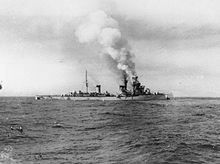Alberto di Giussano class
|
The Alberto di Giussano
|
||||||||||||||
|
||||||||||||||
|
||||||||||||||
|
||||||||||||||
|
||||||||||||||
The Alberto di Giussano class was a class of light cruisers in the Italian Navy . The class consisted of four ships built in Genoa and Castellammare di Stabia near Naples in the late 1920s :
These four ships formed the beginning of the so-called " Condottieri " classes. They were distinguished by their high speed, which could be achieved by criminally neglecting the armor. All four ships of this class were sunk by British torpedoes . The following four classes ( Cardorna -, Montecuccoli -, Duca-d'Aosta - and Duca-degli-Abruzzi -class ; two light cruisers each) represented a continuous improvement of the Giussano -class up to 1937, especially in the area of armor Top speeds could be maintained through improved propulsion systems; only in the Abruzzi class were minor concessions made in terms of speed for additional armor.
Technical specifications
Main dimensions
- Overall length: 169.3 m
- Width overall: 15.5 m
- Draft: 5.3 m
- Displacement: 6,954 ts (maximum)
Propulsion system
- 6 steam boilers , 95,000 hp
- 2 turbines, 2 screws
- Top speed: 37 kn (up to 42 during testing)
- Range: 3,800 nm at 18 kn
Armor
- Vertical: 24 mm
- Horizontal: 20 mm
- Artillery: 23 mm
- Superstructures: 40 mm
Crew and armament
- Crew: 507 men
- 8 × 152 mm L / 53 in four twin towers
- 6 × 100 mm L / 47 in three double towers
- 8 × 37 mm L / 54 flak
- 8 × 13.2 mm MG
- 4 × 553 mm torpedo tubes
Calls
Alberto di Giussano
The cruiser Alberto di Giussano operated in the western Mediterranean during the Spanish Civil War . On June 10, 1940, the ship was part of the 4th cruiser squadron ( Taranto ), with which it took part in the naval battle at Punta Stilo in July . In August, the cruiser moved sea mines near Pantelleria , after which it secured convoys to North Africa. In December 1941, the cruisers Alberto di Giussano and Alberico da Barbiano brought 2,000 tons of aviation fuel from Palermo to Tripoli . The British leadership knew about the operation thanks to Ultra information and sent a squadron of destroyers consisting of four ships equipped with radar to intercept the two Italian cruisers. The four destroyers surprised the Italian ships on December 13, 1941 at 3:25 a.m. at Cape Bon and sank them. The jet fuel caused an inferno of flames that killed over 900 Italian sailors. The commander of the 4th Cruiser Division, Admiral Toscano, was also killed.
Alberico da Barbiano
This cruiser was also part of the 4th Cruiser Division and shared the fortunes of the cruiser Alberto di Giussano , with whom it went down on December 13, 1941 at Cap Bon.
Bartolomeo Colleoni
The cruiser Bartolomeo Colleoni operated in the Mediterranean until November 1938 and was then sent to Shanghai , where it replaced the cruiser Montecuccoli in the Italian East Asia Squadron. After the outbreak of World War II, the ship was ordered back to Italy, where in 1940 it formed the 2nd cruiser division ( La Spezia ) together with the cruiser Giovanni dalle Bande Nere . From June 1940 the Bartolomeo Colleoni was used for mine-laying and convoy security tasks. On July 17, 1940, the 2nd Cruiser Division was en route from Tripoli to Leros in the Aegean Sea . On July 19, at 7:30 a.m., the two Italian cruisers encountered four British destroyers near Crete and went into pursuit. The British destroyers retreated northward to lure the Italians to the Australian cruiser Sydney and an escort destroyer. At 8:29 a.m., the Australian cruiser opened the battle. At 9:23 a.m., the cruiser Bartolomeo Colleoni received a hit that made it unable to maneuver. The British destroyers were able to torpedo and sink the cruiser, which was still firing in this position, at 9:59 a.m. 121 Italian seafarers were killed. The cruiser Giovanni dalle Bande Nere was damaged and withdrew to Benghazi . In addition to a British destroyer, the Sydney was also slightly damaged. The Australian cruiser withdrew due to a lack of ammunition.
Giovanni dalle Gang Nere
This cruiser was also part of the 2nd cruiser division and shared the fortunes of the cruiser Alberto di Giussano until July 19, 1940 . After that he usually operated together with the battleship Littorio , with which it took part in the second Syrtegefecht on March 22, 1942 . A short time later, the British submarine Urge sank him near Stromboli .


